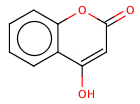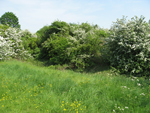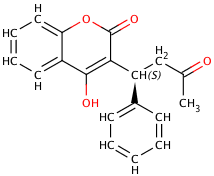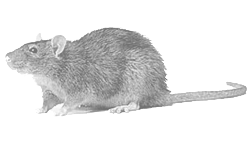The Coumarins
 4-hydroxycoumarin is a fungal metabolite, and starting chemical
in the preparation of Warfarin.
The phytochemical coumarin {2H-chromen-2-one} is the
parent of a series of natural products. Coumarin has
a vanilla-like odour, and the odour of freshly cut grass or new-mown hay
will be familiar to most people. The coumarins occur naturally in essential
oils such as Cinnamon, Lavender, Tonka, Lemongrass, Rose, Tagettes,
and Tarragon. Perfumers have used various coumarins since the early
1800s. Nowadays you can find coumarins in the fresh handmade cosmetics
sold by a company such as Lush.
The name coumarin derives from the Tupi language of French Guiana
where "cumaru" or "kumaru" is a flowering tree which produces black
coumarin containing
Tonka beans.
4-hydroxycoumarin is a fungal metabolite, and starting chemical
in the preparation of Warfarin.
The phytochemical coumarin {2H-chromen-2-one} is the
parent of a series of natural products. Coumarin has
a vanilla-like odour, and the odour of freshly cut grass or new-mown hay
will be familiar to most people. The coumarins occur naturally in essential
oils such as Cinnamon, Lavender, Tonka, Lemongrass, Rose, Tagettes,
and Tarragon. Perfumers have used various coumarins since the early
1800s. Nowadays you can find coumarins in the fresh handmade cosmetics
sold by a company such as Lush.
The name coumarin derives from the Tupi language of French Guiana
where "cumaru" or "kumaru" is a flowering tree which produces black
coumarin containing
Tonka beans.
 Coumarins can be synthesised via the Pechmann condensation.
Thus phenol reacts with ethylacetoacetate in the presence of aluminium trichloride
in nitrobenzene above 100°C to produce 4-methylcoumarin in high yield.
Coumarins can be synthesised via the Pechmann condensation.
Thus phenol reacts with ethylacetoacetate in the presence of aluminium trichloride
in nitrobenzene above 100°C to produce 4-methylcoumarin in high yield.
Warfarin

The author found himself the somewhat unwilling recipient of Warfarin tablets
after diagnosis of AF - a medical condition which is much more prevalent than
many people, including GPs realize. The idea of consuming rat poison, albeit in
milligram amounts, is not very appealing! Modern rats have found some routes
around the poison, either through the suspicions of an intelligent animal (they
are very wary of new food items),
or through natural selection.
 Rattus rattus, the common black rat and its
northern temperature cousin the brown rat, rattus norvegicus,
are vectors for some very unpleasant
diseases such as bubonic plague, typhus, Weil's disease, toxoplasmosis
and trichinosis. In 1920’s North American cattle were dying from internal
haemorrhaging, the poison source turned out to be from mouldy clover leaf silage.
From these observations Warfarin was developed. Rat immunity to Warfarin
appeared within ten years of its use as a rodenticide, and has
forced the development of other "super-warfarins" such as
brodifacoum, another
4-hydroxycoumarin. However this highly toxic poison is very persistent,
is lipid soluble, and has been classed as an environmental pollutant.
Rattus rattus, the common black rat and its
northern temperature cousin the brown rat, rattus norvegicus,
are vectors for some very unpleasant
diseases such as bubonic plague, typhus, Weil's disease, toxoplasmosis
and trichinosis. In 1920’s North American cattle were dying from internal
haemorrhaging, the poison source turned out to be from mouldy clover leaf silage.
From these observations Warfarin was developed. Rat immunity to Warfarin
appeared within ten years of its use as a rodenticide, and has
forced the development of other "super-warfarins" such as
brodifacoum, another
4-hydroxycoumarin. However this highly toxic poison is very persistent,
is lipid soluble, and has been classed as an environmental pollutant.
New anticoagulants medicines have been developed, we also need to
stop fighting natural selection by trying to develop even more potent
super-warfarins.
 4-hydroxycoumarin is a fungal metabolite, and starting chemical
in the preparation of Warfarin.
The phytochemical coumarin {2H-chromen-2-one} is the
parent of a series of natural products. Coumarin has
a vanilla-like odour, and the odour of freshly cut grass or new-mown hay
will be familiar to most people. The coumarins occur naturally in essential
oils such as Cinnamon, Lavender, Tonka, Lemongrass, Rose, Tagettes,
and Tarragon. Perfumers have used various coumarins since the early
1800s. Nowadays you can find coumarins in the fresh handmade cosmetics
sold by a company such as Lush.
The name coumarin derives from the Tupi language of French Guiana
where "cumaru" or "kumaru" is a flowering tree which produces black
coumarin containing
Tonka beans.
4-hydroxycoumarin is a fungal metabolite, and starting chemical
in the preparation of Warfarin.
The phytochemical coumarin {2H-chromen-2-one} is the
parent of a series of natural products. Coumarin has
a vanilla-like odour, and the odour of freshly cut grass or new-mown hay
will be familiar to most people. The coumarins occur naturally in essential
oils such as Cinnamon, Lavender, Tonka, Lemongrass, Rose, Tagettes,
and Tarragon. Perfumers have used various coumarins since the early
1800s. Nowadays you can find coumarins in the fresh handmade cosmetics
sold by a company such as Lush.
The name coumarin derives from the Tupi language of French Guiana
where "cumaru" or "kumaru" is a flowering tree which produces black
coumarin containing
Tonka beans. Coumarins can be synthesised via the Pechmann condensation.
Thus phenol reacts with ethylacetoacetate in the presence of aluminium trichloride
in nitrobenzene above 100°C to produce 4-methylcoumarin in high yield.
Coumarins can be synthesised via the Pechmann condensation.
Thus phenol reacts with ethylacetoacetate in the presence of aluminium trichloride
in nitrobenzene above 100°C to produce 4-methylcoumarin in high yield.



 Rattus rattus, the common black rat and its
northern temperature cousin the brown rat, rattus norvegicus,
are vectors for some very unpleasant
diseases such as bubonic plague, typhus, Weil's disease, toxoplasmosis
and trichinosis. In 1920’s North American cattle were dying from internal
haemorrhaging, the poison source turned out to be from mouldy clover leaf silage.
From these observations Warfarin was developed. Rat immunity to Warfarin
appeared within ten years of its use as a rodenticide, and has
forced the development of other "super-warfarins" such as
Rattus rattus, the common black rat and its
northern temperature cousin the brown rat, rattus norvegicus,
are vectors for some very unpleasant
diseases such as bubonic plague, typhus, Weil's disease, toxoplasmosis
and trichinosis. In 1920’s North American cattle were dying from internal
haemorrhaging, the poison source turned out to be from mouldy clover leaf silage.
From these observations Warfarin was developed. Rat immunity to Warfarin
appeared within ten years of its use as a rodenticide, and has
forced the development of other "super-warfarins" such as